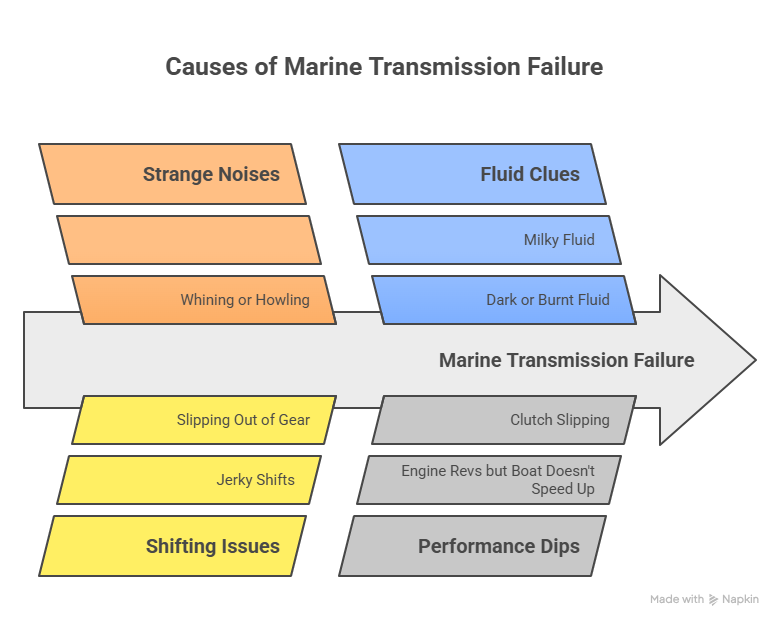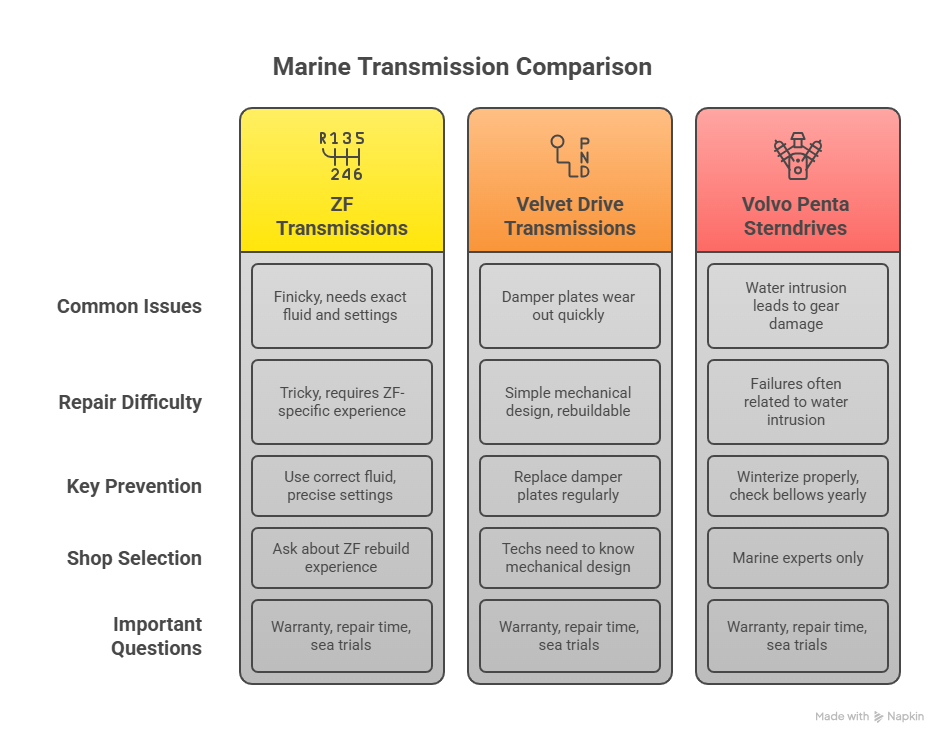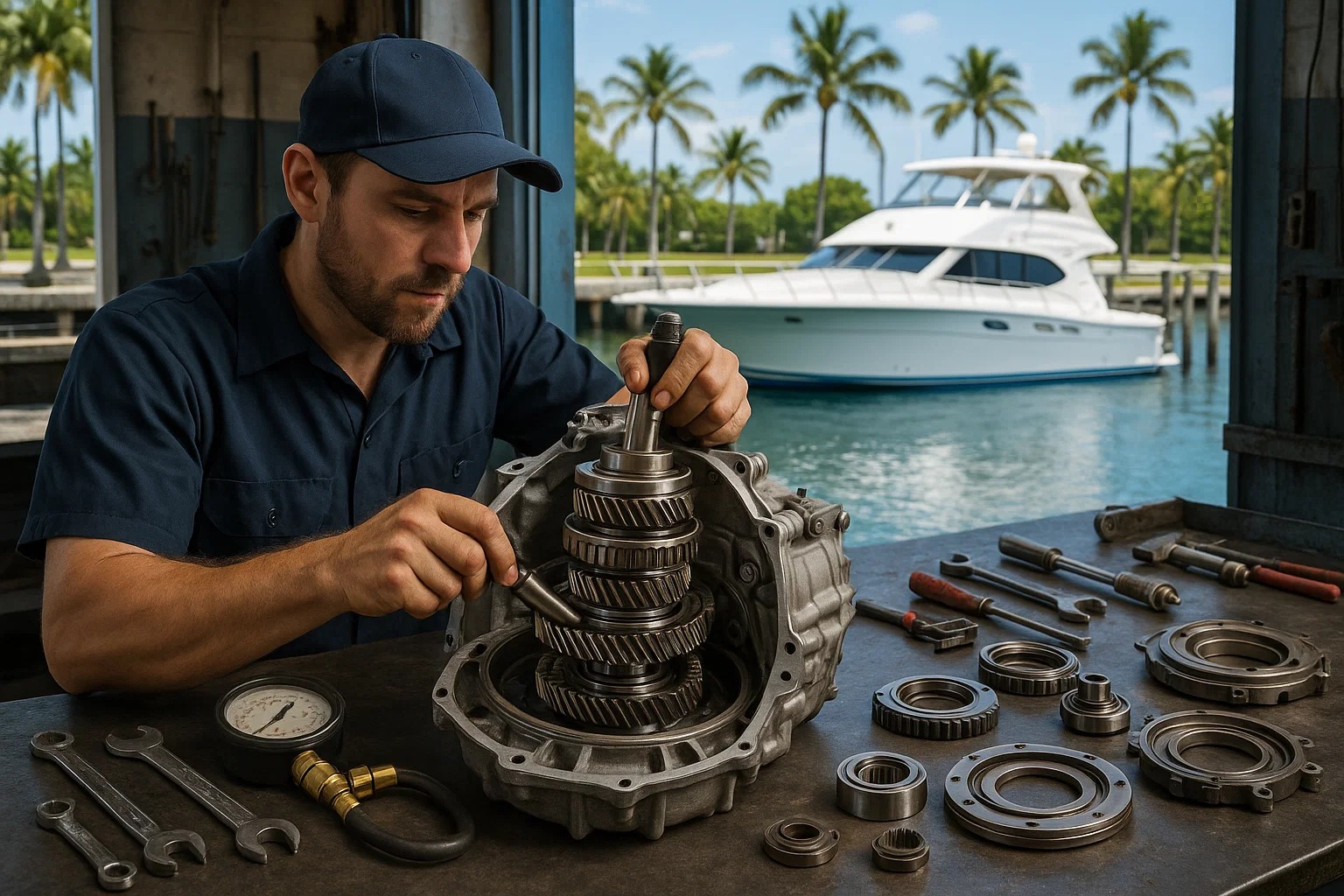Marine Transmission Repair Near Me: 15 Years of Fixes and Lessons Learned
I’ve been wrenching on boat transmissions in South Florida for 15 years, and I’ve seen every way they can go wrong—clunking gears, slipping clutches, you name it. Last June 2024, a guy named Javier rolled into Dinner Key Marina with his 2019 Sea Ray 310, swearing his boat had a “weird delay” when shifting. Weird? Not really. I hooked up a pressure tester and found his ZF transmission’s hydraulic pressure was off—30 PSI instead of the 200 PSI it needed. Fixed it for $800, saving him a $3,000 rebuild. Here’s my playbook for spotting transmission trouble, fixing it right, and finding a solid shop for marine transmission repair near me in places like Miami or Fort Lauderdale.
Table of Contents
What Are the Warning Signs of Marine Transmission Failure?
Your boat’s transmission is the unsung hero, turning engine power into smooth motion. When it starts acting up, it’s like your boat’s yelling for help. Ignoring it can turn a $500 fix into a $5,000 tow—or worse, leave you stranded off Key Biscayne.
I learned this the hard way back in 2011. A client at Bahia Mar ignored a whining noise in his Velvet Drive transmission. By the time he called me, the gears were shot—$4,000 rebuild. Here’s what to watch for:
- Strange Noises: Whining or howling usually means low fluid or early gear wear. Clunking when shifting points to a bad damper plate or worn gears. Grinding? Stop the boat—now.
- Shifting Issues: Jerky shifts or slipping out of gear scream clutch or hydraulic problems. Javier’s Sea Ray had a 2-second delay—classic low-pressure issue.
- Fluid Clues: Check your transmission fluid monthly. Milky fluid means water intrusion (probably a bad cooler). Dark, burnt-smelling fluid? Overheating’s killing your parts.
- Performance Dips: If your engine revs but the boat doesn’t speed up, your clutch is slipping. I saw this on a Boston Whaler last summer—cost $1,200 to fix.
Act fast on these signs. A quick fluid check or dockside test can save you from a season-ending breakdown.
Why Does Water Intrusion Wreck Marine Transmissions?
Water in your transmission is a death sentence. It’s the top reason I see boats towed back to Coconut Grove. Milky fluid means water’s snuck in, usually through a failed cooler or bad seals. Last July, Maria’s Grady-White 208 at Stiltsville had this issue—her cooler was cracked, and the clutch pack was toast. Cost her $2,500 to rebuild.
Water corrodes bearings and ruins clutches in weeks. I always pressure-test coolers with a radiator tester (15 PSI, 30 minutes) to catch leaks early. If you see milky fluid, don’t run the engine—call a pro immediately.

How Do I Check My Transmission Fluid Properly?
Your transmission fluid is your first clue to trouble. I check mine every month, and it’s saved me from plenty of headaches. Here’s how I do it:
- Pull the dipstick after a short run (warm fluid’s more accurate). Wipe it, reinsert, and check the level.
- Look for color and smell. Clear red or amber is good. Milky means water; dark or burnt means overheating.
- I cut open old filters to check for metal shavings—caught gear wear early on a client’s Yamaha last year.
If anything’s off, get a pro to run a pressure test. It’s a $150 job that can save you thousands.
What’s the Difference Between a Repair and a Full Rebuild?
Not every issue needs a full rebuild, but guessing wrong costs money. I learned this from an old mechanic named Ray in 2012—he’d tear down every transmission to find the real problem, not just swap parts. Here’s the breakdown:
- Minor Repairs: Fluid changes ($200–$400), seal replacements ($300–$600), or cooler fixes ($500–$1,200). These are quick, often dockside.
- Major Repairs: Fixing a damper plate or clutch pack ($800–$1,800). Needs shop work but not a full teardown.
- Full Rebuild: For trashed gears or clutches ($1,500–$4,000). I strip the unit, replace worn parts with OEMs, and bench-test it to ZF or Velvet Drive specs.
Last month, a guy at Key Biscayne saved $2,000 by catching a seal leak early—no rebuild needed. Know your issue before you commit.
How Much Does Marine Transmission Repair Near Me Cost?
Costs depend on your transmission and the damage. Here’s a table I put together from jobs I’ve seen in South Florida:
| Service Type | Description | Cost Range | Availability |
|---|---|---|---|
| Fluid/Filter Service | Replace fluid and filter with marine-grade ATF | $200–$400 | Most shops, mobile |
| Seal Replacement | Fix external leaks (gaskets, seals) | $300–$600 | Most shops |
| Cooler Service | Clean/test cooler to prevent water intrusion | $500–$1,200 | Specialty shops |
| Full Rebuild | Teardown, replace parts, bench-test | $1,500–$4,000 | In-house shops |
A rebuild’s cheaper than a new unit ($5,000–$10,000). I always push for rebuilds with OEM parts—same performance, half the price.
Why Are ZF Transmissions Tricky to Repair?
ZF transmissions, common in yachts and sportfishers, are smooth but finicky. They need exact fluid types (ATF Dexron III, not just any oil) and precise hydraulic settings. In 2023, I fixed a ZF 68IV on a Viking 42—low pressure from a worn control block cost $1,800 to repair. Without ZF-specific experience, a shop can botch the clearances, leaving you with a $3,000 redo. Ask your mechanic, “How many ZFs have you rebuilt?” If they hesitate, walk away.
What Makes Velvet Drive Transmissions Different?
Velvet Drives are old-school, bulletproof inboards, but they’ve got quirks. Damper plates wear out every 1,000 hours, causing clunks. I saw this on a Bertram 31 last spring—$900 fix. Parts are cheap and plentiful, but you need a tech who knows their simple mechanical design. They’re rebuildable forever if done right.

How Do Volvo Penta Sterndrives Fail?
Volvo Penta sterndrives are part of the outdrive, so failures often tie to water intrusion. Bellows or seals fail, and saltwater eats the gears. Last August, a client’s Volvo Penta DPS-M at Coconut Grove was wrecked from bad bellows—$3,200 to rebuild the upper unit. Winterize properly, and check bellows yearly to avoid this.
How Do I Find a Reliable Marine Transmission Repair Shop Near Me?
Finding a good shop in South Florida is like finding a good fishing spot—takes some digging. I walked away from a shop once that promised a same-day ZF rebuild—yeah, right. Here’s what I look for:
- Marine Experts Only: Automotive shops don’t cut it. Pick a shop that lives and breathes boats, like Sofia’s Marine Repair in Fort Lauderdale.
- Brand Experience: Ask, “How many Velvet Drives or ZFs have you rebuilt?” I’d want at least 20 under their belt.
- In-House Rebuilding: Shops that rebuild on-site control quality. Outsourcing means delays and sketchy parts.
- Clear Estimates: Get a written quote with parts, labor, and a 1-year warranty. Vague quotes are trouble.
Last year, a buddy at Bahia Mar found a shop through Yelp reviews—saved him $1,000 on a clean rebuild.
What Questions Should I Ask a Repair Shop?
Before you hand over your boat, grill the shop like you’re hiring a surgeon. Here’s my checklist:
- What’s your warranty on rebuilds? (Expect 1 year minimum.)
- How long will the repair take? (1–2 weeks for rebuilds is standard.)
- Do you do sea trials post-repair? (They should.)
- What caused the failure, and how do I prevent it? (Good shops explain.)
A pro won’t dodge these. If they do, find another shop.
FAQ: Marine Transmission Repair Near Me
How Often Should I Check My Transmission Fluid?
Check it monthly, like I do. Pull the dipstick after a short run, look for clear red fluid, and sniff for burnt smells. Milky fluid means water intrusion—get it to a shop fast. A $50 check can save you a $3,000 rebuild.
What’s the Cost of a Marine Transmission Rebuild?
Rebuilds run $1,500–$4,000, depending on the brand and damage. I’ve seen ZF rebuilds hit $3,500, while Velvet Drives can be $1,800. Compare that to $5,000–$10,000 for a new unit. Always get a written estimate first.
Can I Do Transmission Repairs Myself?
Simple stuff like fluid changes ($200–$400) or seal swaps ($300–$600) is doable if you’re handy. I showed a guy at Key Biscayne how to swap fluid in 20 minutes. But clutch or gear work? Leave it to pros with pressure testers and OEM parts.
Why Do Marine Transmissions Fail?
Water intrusion, overheating, or worn clutches are the big ones. I saw a Yanmar fail last summer from bad fluid—$2,800 fix. Check fluid regularly, use marine-grade ATF, and pressure-test coolers yearly to avoid trouble.
How Long Does a Transmission Repair Take?
Fluid changes take a day; rebuilds, 1–2 weeks. A shop in Fort Lauderdale rushed a Volvo Penta job for me in 5 days last July, but they had in-house rebuilding. Ask for a firm timeline upfront.
What’s the Best Shop for Marine Transmission Repair Near Me?
Look for marine specialists with brand experience (e.g., ZF, Velvet Drive). Check Yelp or ask at marinas like Bahia Mar. I trust shops like Sofia’s Marine Repair—they’ve done 30+ ZF rebuilds with 1-year warranties.
How Can I Prevent Transmission Problems?
Keep fluid fresh, check for leaks, and test coolers yearly. I add a $10 additive to my fluid to fight water intrusion—saved me once in 2022. Regular checks keep you off the tow truck.
Conclusion: Get Back on the Water with Confidence
Your transmission’s not just gears—it’s your ticket to worry-free boating. A bad repair can leave you stranded off Stiltsville, cursing a $5,000 tow. I’ve seen it too many times in Miami.
Pick a shop with marine expertise, brand-specific know-how, and in-house rebuilding. Get a written estimate with a 1-year warranty. Check your fluid today—it’s a 5-minute job that tells you a lot. Then call two local shops, ask about their experience with your transmission, and get back to making memories on the water.
Author Bio
I’m Alex, a 15-year marine mechanic with ABYC certification, based in Fort Lauderdale. I’ve rebuilt 200+ transmissions, from Velvet Drives to Volvo Pentas, across South Florida’s marinas.


Leave a Reply